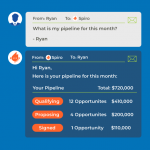The Ford Foundation Just Made A Billion Dollar Bet On Impact Investing
Like many major philanthropic funders, the Ford Foundation for social justice spends roughly 5% of its annual endowment on charitable causes, reinvesting the rest to ensure it will be able to recoup those costs and operate in perpetuity.
With a total endowment of about $ 12 billion, that means there’s about $ 600 million granted toward charitable programs each year. (That 5% figure is the minimum requirement to maintain nonprofit status under federal tax code.) But it also means that 95% of the foundation’s money is sitting in stocks, private equity, real estate, and venture capital, not leveraged in the same socially responsible manner that the foundation insists on when making its grants.
In recent years, president Darren Walker has grown uncomfortable with that imbalance, which he sees as another “classic disconnect” affecting well-funded but sometimes apathetic institutions, including Ford. “We won’t solve big problems without deploying some part of that 95%,” Walker says. “So what I’m hoping is that we are reaching an inflection point, a tipping point in which the momentum has shifted to normalize a conversation about how foundations use our endowments from the margins to the mainstream. For too long this question has been sidelined. And I think the time has come where we’ve got to take it on and we’ve got to demonstrate the capacity to use our endowment to advance our mission.”

[Source Images: Tukkki/iStock, missbobbit/iStock]
To that end, Walker announced plans to use up to $ 1 billion of the foundation’s endowment over the next decade on more mission-related investments, investments in projects that generate the return Ford needs, but also support things like affordable housing or better financial services for the poor. The logic is explained in detail in a post entitled “Unleashing the power of endowments: The next great challenge for philanthropy” on Ford’s Equals Change blog. The commitment makes Ford the largest private foundation playing in this space.
According the Global Impact Investing Network (GIIN), an industry group that’s tracking market trend, impact investment has grown rapidly. In its network alone, there are over 2,500 different investors contributing to more than 400 funds, which have grown in size from $ 15 billion in contributions two years ago to more than $ 77 billion in 2016.
According to GIIN, typical investments include things like an organization that needs capital for their own revolving-loan-based community development program, or to fund wind farms in areas where the demand for power dwarfs the current supply, which in addition to putting clean energy back into the grid would generate revenue through carbon offset agreements. Another group could invest in a traditional company whose business plan, say, the launch of a shea butter company for organic nut farmers in rural Ghana, provides jobs and economic stability in depressed areas. Unlike traditional investments, these opportunities offer both money back and the chance to fix some larger environmental or social cause, often in a way that could draw more investors as the business model proves out.
Xavier de Souza Briggs, the Ford Foundation’s vice president for economic opportunity and markets, puts the value of the emerging market for impact investments at north of a trillion dollars, as managers of union pension funds, sovereign wealth funds, and high net worth individuals start taking an interest. Part of the reason is that the IRS has formalized standards for using MRIs while various impact investment groups have created a fund and company rating program, and come up with a universal standard for performance metrics to show investors what combination of revenue, social, and environmental impacts might be expected. With that, the market has opened up to a wider swath of investors, and the money is flowing.
In a way, Walker set the groundwork for this kind of shake-up several months ago when he rallied against Ford’s inherent privilege problem, complaining that a feeling of self-importance often insulates foundations from auditing the effectiveness of their work. The goal now is to prove the potential of this new kind of investing so that other players, especially foundations, will follow suit and put their money to better use as it’s generating returns.

More broadly, such moves would address a fundamental flaw of the in-perpetuity model of charity. While some organizations have converted to a limited-life philosophy, opting to spend down their endowments to create larger, more immediate impacts, many groups still follow the traditional model: allocating about the same amount each year, even as the complexity of global challenges continues to grow. “Too many people are being left behind today, that’s the larger challenge here,” Walker says. “And therefore we have to disrupt our traditional ideas about how we invest and we have to do it responsibly and prudently.” Ford’s goal is to build a large model that “demonstrates that you can achieve an attractive [financial] return and achieve a social return” simultaneously, giving foundations a chance to exist in perpetuity while also making change via their investment strategies.
Mission-related investments (MRIs) are different than program-related investments (PRIs), which generally fall under the umbrella of the 5% foundations give away. The key difference is that PRIs, which Ford has used in various ways starting in the late-’60s, can have a much lower rate of return and default risk than MRIs, which because of their sheer size and ability to shift markets must meet different IRS standards to be considered a sound investment–and must generate enough money to keep the foundation solvent.
Ford grants plenty of non-recoverable funds to causes–that’s why they keep the rest of their endowment invested elsewhere. But over the past five decades, they’ve made program-related investments in groups tackling issues like urban development, homeownership, and microfinance in hope of making change and recouping a bit of that up-front cost. In a sense, this was the group’s pilot program. The difference is that they were spending millions, not billions, so they could afford to watch a few ambitious plans default.
Plenty of other funders are also exploring the space, including, as Walker notes in his post, the Rockefeller, Kellogg, MacArthur, and Gates foundations. There’s also a formal network of groups called Mission Investors Exchange that are combining lessons to create more knowledge about the market. Ford plans to collect its own lessons, and share them at intervals.

[Source Images: Tukkki/iStock, missbobbit/iStock]
So far, there’s at least one takeaway for emerging entrepreneurs. “Increasingly we’ll be asking this question, ‘How are you thinking by the way about the social impact? How are you thinking beyond the financial bottom line?’” says de Souza Briggs. The hope is that Ford’s spending creates an environment that’s “mutually reinforcing,” meaning as more people become aware of the windfall available to socially good ventures, more founders will structure their companies accordingly. “We hope to both encourage more deal flow and encourage more product development, Walker adds.
Of course, nothing the foundation does will be able to offset the funding void that could happen if the Trump administration follows through with its deep cuts to domestic spending and foreign aid. Walker declined to directly address whether the foundation is critical of the president’s proposed budget. Instead, he offered a disclaimer (“without getting political”), and shared the obvious: “I think we are kidding ourselves if we think we can we can reduce inequality without a robust investment from governments. Or that we can build a more inclusive economy or ensure that more people are working without a robust investment from government.”
In his view, Ford’s shift may begin to make up for a missed opportunity but it’s not enough to let others fold at that table. “We’ve got to have an engaged private sector and a robust government investment to keep the kind of progress we need [going] as a society,” he says.
(28)














